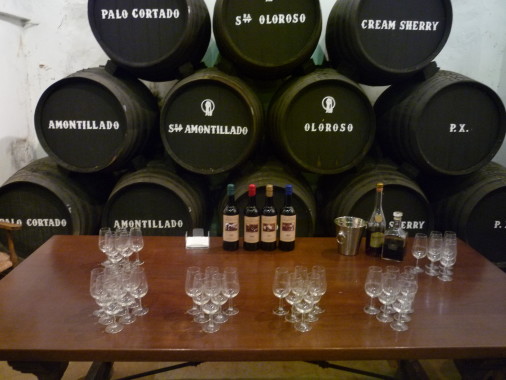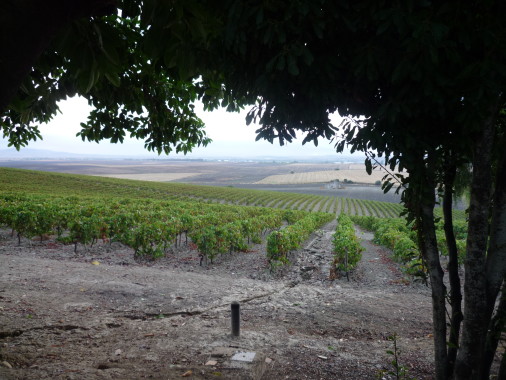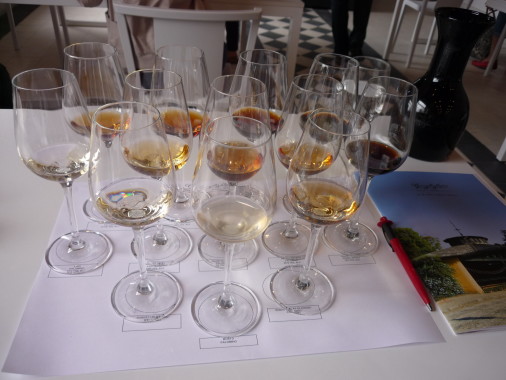Like us on Facebook

The simple mention of the word sherry can conjure up images of grey-haired ladies sipping a cloyingly sweet wine out of thimble-sized glasses, while playing bridge in a cold English farm house. Or perhaps an old, dusty bottle in the back of the liquor cabinet used exclusively for cooking purposes also comes to mind? Sherry is indeed one of the most misunderstood wines of the world, offering a dizzying array of styles from bone-dry to lusciously sweet. With a bit of education, there is no reason why sherry cannot find its place again as one of the world’s most sought after wines. After years of declining sales, this fortified Spanish wine is beginning to see a renaissance in the fine wine community and is now found in the best restaurants and wine bars of the world.
Context Travel recently visited Jerez de la Frontera in the Andalucía region to learn more about these fascinating wines and their time-honored production methods. Sherry is produced from the Palomino grape variety grown in the “sherry triangle” located between the cities of Jerez de la Frontera, Sanlúcar de Barrameda and El Puerto de Santa Maria. These vineyards form what is Europe’s most southerly vine-growing area.

The juice from these grapes is fermented into a bone-dry white wine. The next step will be to fortify this young wine with a neutral grape spirit. Not only does this step help determine the wine’s future and how it will evolve during the ageing process, it historically allowed for the wines to travel, as they could better support long journeys at sea.
After fortification, the sherry is then aged in a unique fashion: the solera system. When a newly made wine is added to the top row of barrels in the system, existing wines are blending downward to create space for the young wine. In doing so, young wines are mixed with medium aged wines, medium aged wines with older wines, and older wines with even older wines and so on. When the wine is ready to be bottled, no more than 30% of the bottom row (the oldest wine) of the system will be drawn off and sold.
This method of fractional blending gives wines of incredible complexity and nuanced flavor, while ensuring consistency from batch to batch. When you buy a bottle of sherry, the wines inside the bottle may in fact be anywhere from 5 to 50+ years old!

Here is a brief explanation of the major styles of sherry:
Fino (or manzanilla – a fino from the city of Sanlúcar): the lightest and most pale style of sherry, aged in barrels under a layer of naturally occurring yeast, or flor in Spanish, which protects the wine. Finos are the traditional pairing for tapas such as Iberico ham, olives, almonds, and seafood of any kind. They are incredibly versatile wines and can be consumed with a wide array of lighter fare.
Oloroso: Fortified to a higher degree than a fino, this wine will never grow flor, allowing the wine to age in contact with oxygen. The result is burnished in color, rich and nutty with a dash of caramel. Olorosos pair beautifully with red meat and game dishes, meat stews and charcuterie.
Amontillado: An intermediate style of sherry that starts life protected under flor as a fino but will be exposed to oxygen after the flor dies off. The finest examples combine the delicate nature of a fino with the power and body of an oloroso, tasting of roasted nuts and toffee with an underlying elegance of a fino. Amontillados go well with soup, poultry and rich pâtés.
The above sherries are all dry, however within the Jerez region, sweet wines are also produced from the Pedro Ximinez grape which can be blended in to dry sherry to make cream sherry. Cream sherry can be served as a digestive or with dried or candied fruits, nuts or chocolate.
The region’s history and unique production methods combined with sherry’s flexibility in food pairing make it one of the most interesting wines to try. Sherry also represents an excellent value for money and an opportunity to try some very old wines without breaking the bank. I guarantee that once you try a good one, the complex and lingering flavors will continue to haunt you, drawing you back for more and making you a sherry convert for life.
This great overview of Spanish Sherry presented by our partners, Context Travel

The simple mention of the word sherry can conjure up images of grey-haired ladies sipping a cloyingly sweet wine out of thimble-sized glasses, while playing bridge in a cold English farm house. Or perhaps an old, dusty bottle in the back of the liquor cabinet used exclusively for cooking purposes also comes to mind? Sherry is indeed one of the most misunderstood wines of the world, offering a dizzying array of styles from bone-dry to lusciously sweet. With a bit of education, there is no reason why sherry cannot find its place again as one of the world’s most sought after wines. After years of declining sales, this fortified Spanish wine is beginning to see a renaissance in the fine wine community and is now found in the best restaurants and wine bars of the world.
Context Travel recently visited Jerez de la Frontera in the Andalucía region to learn more about these fascinating wines and their time-honored production methods. Sherry is produced from the Palomino grape variety grown in the “sherry triangle” located between the cities of Jerez de la Frontera, Sanlúcar de Barrameda and El Puerto de Santa Maria. These vineyards form what is Europe’s most southerly vine-growing area.

The juice from these grapes is fermented into a bone-dry white wine. The next step will be to fortify this young wine with a neutral grape spirit. Not only does this step help determine the wine’s future and how it will evolve during the ageing process, it historically allowed for the wines to travel, as they could better support long journeys at sea.
After fortification, the sherry is then aged in a unique fashion: the solera system. When a newly made wine is added to the top row of barrels in the system, existing wines are blending downward to create space for the young wine. In doing so, young wines are mixed with medium aged wines, medium aged wines with older wines, and older wines with even older wines and so on. When the wine is ready to be bottled, no more than 30% of the bottom row (the oldest wine) of the system will be drawn off and sold.
This method of fractional blending gives wines of incredible complexity and nuanced flavor, while ensuring consistency from batch to batch. When you buy a bottle of sherry, the wines inside the bottle may in fact be anywhere from 5 to 50+ years old!

Here is a brief explanation of the major styles of sherry:
Fino (or manzanilla – a fino from the city of Sanlúcar): the lightest and most pale style of sherry, aged in barrels under a layer of naturally occurring yeast, or flor in Spanish, which protects the wine. Finos are the traditional pairing for tapas such as Iberico ham, olives, almonds, and seafood of any kind. They are incredibly versatile wines and can be consumed with a wide array of lighter fare.
Oloroso: Fortified to a higher degree than a fino, this wine will never grow flor, allowing the wine to age in contact with oxygen. The result is burnished in color, rich and nutty with a dash of caramel. Olorosos pair beautifully with red meat and game dishes, meat stews and charcuterie.
Amontillado: An intermediate style of sherry that starts life protected under flor as a fino but will be exposed to oxygen after the flor dies off. The finest examples combine the delicate nature of a fino with the power and body of an oloroso, tasting of roasted nuts and toffee with an underlying elegance of a fino. Amontillados go well with soup, poultry and rich pâtés.
The above sherries are all dry, however within the Jerez region, sweet wines are also produced from the Pedro Ximinez grape which can be blended in to dry sherry to make cream sherry. Cream sherry can be served as a digestive or with dried or candied fruits, nuts or chocolate.
The region’s history and unique production methods combined with sherry’s flexibility in food pairing make it one of the most interesting wines to try. Sherry also represents an excellent value for money and an opportunity to try some very old wines without breaking the bank. I guarantee that once you try a good one, the complex and lingering flavors will continue to haunt you, drawing you back for more and making you a sherry convert for life.
No comments:
Post a Comment